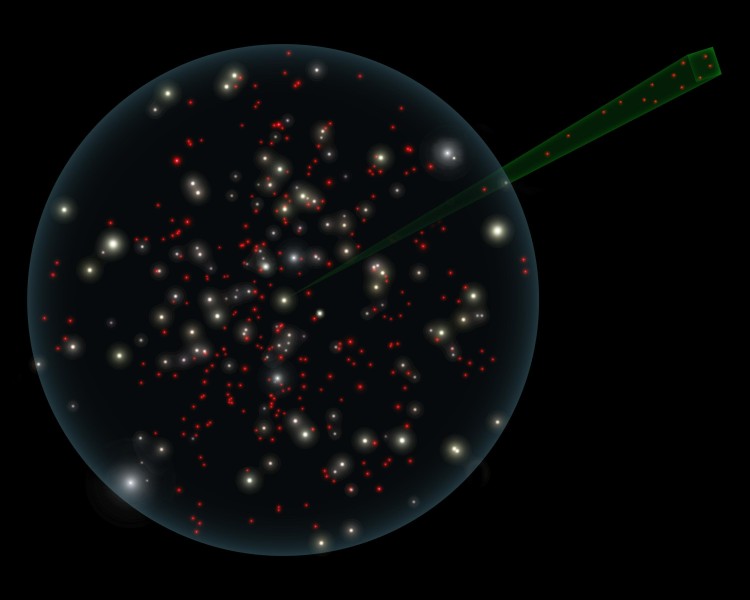

When we think of stars, we envision immensely large, hot, and bright balls of super-heated plasma. However, the universe throws us many curve-balls. One thing that is counter-intuitive to the way we think things should be is the brown dwarf: an object that literally turns the general perception of what a star is on its head. Not only are they rather small (rarely are they ever much larger than 40 or 50 Jupiter-sized planets) and dim, but they can also be quite cold. Scientists have found several of these so-called “failed stars” that range in temperature from a cup of coffee, to cold-to-the-touch.
Most recently, astronomers have stumbled across a star that is effectively colder than ice. Moreover, the star is located in the galactic equivalent of our backyard—just 7.2 light-years from Earth.
If it sounds strange that it took so long to find one of the Sun’s closest neighbors, it’s about to get stranger. The image below shows the location of hundreds of brown dwarfs predicted to exist nearby, and may soon be discovered by NASA’s “Wide-field Infrared Survey Explorer” (WISE).

These low-mass stars are pictured in red, while other known main-sequence stars (like the Sun and other low-mass dwarf stars) appear in white, yellow or red (depending on mass and luminosity)
Behind “Failed Stars:”
Astronomers classify stars based on several factors, but mass is most important. It dictates the mechanisms that drive how stars function. As mentioned above, brown dwarf stars are often referred to as “failed stars” (I like to call them the “little stars that couldn’t”). This essentially means that the stars are too massive to be considered a planet, but not massive enough to ignite the chain nuclear reactions that power the Sun and other main-sequence stars.
The next rung up on the stellar-size ladder—with the exception of stars that have died, like neutron stars or white-dwarfs—is the red-dwarf. They may be quite dim, but they are masters of longevity; One can survive for more than a trillion years before it starts nearing the end of its lifespan, which boils down to how the star deals with the material it generates through nuclear fusion. Since brown dwarfs are unable to fuse even the most basic elements in their cores, they aren’t fully-fledged stars, but, unlike planets, they likely don’t form in protoplanetary disks. Instead, they form in the same way other stars do—from the collapse of gas and dust clouds lurking throughout interstellar space.
So as you can see, the definition is arbitrary (at best). To further muddy the waters, they do not have the internal sources of heat planets have. The small bit they do have is residual heat left over from their formation. Planets harbor the same energy, but it’s not the only card in the deck. Planets like Jupiter generate an internal source of energy from the movements of upper atmospheric clouds. Similarly, tidal stresses between other planets and their respective moons help out.
Introducing WISE J085510.83-071442.5:
Just as astronomers predicted back in 2010, we’ve discovered various brown dwarfs over the past few years. Heck, we’ve made great progress within months. First, astronomers were able to accurately determine the volatile weather-patterns on a brown dwarf, then they were able to map the surface features of another brown dwarf located 6 light-years away.
One of the newest discoveries, dubbed WISE J085510.83-071442.5, is certainly an unlikely find. WISE scoured the skies over 13 months, looking for the incredibly faint infrared signature of these uber-cold objects. And boy, did it find a treasure trove of uncharted objects; from planets and stellar nurseries, to stars and galaxies. The discovery of WISE J085510.83-071442.5 stood out, and raised the eyebrows of one accomplished astronomer. Kevin Luhman—a professor of astronomy and astrophysics from Pennsylvania State University, who also discovered the Luhman 16AB system—first noticed the incredibly faint, but very fast-moving star.
![Real observations of the star in question. (Credit: ASA/JPL-Caltech/Penn State])](https://futurism.com/wp-content/uploads/2014/04/J0855-Simulation-1.gif?strip=all&quality=85)
This in-and-of itself isn’t unusual. After all, the universe is an ever-moving picture show. Nothing, and I mean nothing, is stationary. What was unusual was that the star was so dim—invisible even to the powerful Gemini telescope—and so fast moving. Such observations indicate that the object in question is close to us, rather than far away. He was also able to see “significant” parallax, which, in this case, refers to a change in position in respect to Earth’s movement around the Sun and to background stars. Together, these things helped pinpoint the star’s location and distance.
The same data also gave insight into the star’s unusually cold temperature. By observing the spectrum of the light it emitted (colder objects tend to be red in color, while the hotter ones are blue), he concluded that the temperatures hang around a nippy 225 to 260 Kelvin (that’s below the freezing point of water).
Despite this, we still couldn’t visit. The temperatures may be survivable, but the star still has one heck of a gravitational pull. If we were to attempt a landing, it would be the last thing we ever do.
With all this in mind, one must ask the obvious question: how many other objects like this one—exceptionally cool and unremarkably bright—reside in our stellar neighborhood? Could this discovery give more credence to the hypothesis that the Sun has an unseen partner? Although possible, Luhman himself rejects the notion.